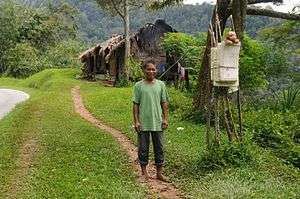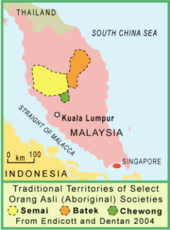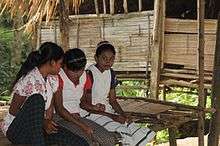Semai people
 | |
| Total population | |
|---|---|
| 49,697 (2010)[1] | |
| Regions with significant populations | |
|
| |
| Languages | |
| Semai language, Malay language | |
| Religion | |
| Forest & Natural Spirituality (a form of Animism) with (Islamic influences/Folk Islam) and a significant minority practicing Christianity or Sunni Islam. | |
| Related ethnic groups | |
| Temiar people, Lanoh people, Javanese people, Khmer people |
The Semai (also known as Mai Semai or Orang Dalam[2]) are a semi sedentary ethnic group living in the center of the Malay Peninsula in Southeast Asia, known especially for their nonviolence.[3] They speak Semai, an Austroasiatic language closely related to Temiar, spoken by Temiars nearby. The Semai belong to the Senoi group and are one of the largest indigenous ethnic group in the Peninsula and the largest of the Senoi group.
Population
The population dynamics of the Semai people in Malaysia:-
| Year | 1960[4] | 1965[4] | 1969[4] | 1974[4] | 1980[4] | 1991[5] | 1993[5] | 1996[4] | 2000[6] | 2003[6] | 2004[7] | 2010[1] |
|---|---|---|---|---|---|---|---|---|---|---|---|---|
| Population | 11,609 | 12,748 | 15,506 | 16,497 | 17,789 | 28,627 | 26,049 | 26,049 | 34,284 | 43,892 | 43,927 | 49,697 |
Origins
_(14781104392).jpg)
It is thought that the Semai are the remnants of the original, ancient and widespread population of Southeast Asia. According to Keene State College's Orang Asli Archive, in 1991 there were 26,627[8] and according to the Center for Orang Asli Concern in 2000 there were 34,248[9] Semai living on the Malay Peninsula. This number has increased in recent years with the advent of better nutrition as well as improved sanitation and healthcare practices. These numbers, however, do not include other peoples of Semai or mixed descent, most of whom have assimilated into other cultures and have abandoned their ancestral tribal lands in order to seek better employment and education opportunities, especially in the larger cities.
A genetic study conducted in 1995 by a team of biologists from the National University of Singapore has shown a close relationship between the Semai and the Khmer of Cambodia. This is in line with the linguistic situation of the Semai, whose language belongs to the Mon-Khmer family. Furthermore, the Semai seem to be more closely related to the Javanese than to their Malay neighbours on the peninsula.[10]
Culture
.jpg)
The Semai are horticulturalists who have a gift economy. They are among the indigenous peoples of Malaysia (see Orang Asli) who have been pushed into the hills and mountains by later, more technologically powerful incoming peoples. They have no police and no government per se. According to Dentan, adults appear to be controlled primarily by public opinion. The Semai themselves say "There is no authority here but embarrassment." Although popular and verbally facile individuals are influential in public affairs, the Semai have no formal leaders.
Disputes in the Semai community are resolved by holding a becharaa, or public assembly, at the headman's house. This assembly may last for days and involves thorough discussion of the causes, motivations and resolution of the dispute by disputants and the whole community, ending with the headman charging either or both of the disputants not to repeat their behavior lest it endanger the community. The Semai have a saying that "there are more reasons to fear a dispute than a tiger."[11]
Semai children are never punished or forced against their will.[12] If a parent asks a child to do something and the child says "I don't want to," the matter is ended. However, Semai parents use fear of strangers and violence in nature such as thunderstorms and lightning to control children's behavior if ever it becomes necessary. A concept similar to karma is also prevalent where children are told stories of sprites (mambang in Malay) and forest spirits who will take retribution if their sanctity is violated. Children also appear to be taught to fear their own aggressive impulses.[13][14] The concept of mengalah or giving in is most cherished where children since young are taught to 'give way' to others so as to preserve the peace and harmony of the village.
The games Semai children play are non-competitive.[15] These games include forms of sports that encourage physical activity and exertions so that the body becomes tired and are therefore made ready for sleep and the subsequent dreaming. One game involves hitting at other children with sticks; the sticks, however, always stop short a few inches from their target so that no one actually gets struck. Modern games are also played but with significant modifications. A game of badminton for example uses no partition nets and keeps no score. The shuttlecock is deliberately hit so that it could be easily intercepted by the other player and passed back, and so forth. The objective seems to be purely for exercise.
With regards to space and dominion, there appears to be no distinction between the public and private realms, and thus, "the Western concept of privacy, domestic or otherwise, is not to be found".[16] This concept is also shared by the rural Malays, of whom, many are descended from mixed marriages with the Semais and other Orang Asli people. They carry with them the wisdom and lore of the Semais, including their non-violent and pacifist tendencies, harmonized with other prevailing religions of their adoption.
The Semais live in villages and most of the structures are built with wood, bamboo with weaved walls and thatched roofs using palm leaves. Semai houses have no visible bedrooms, especially for the children, as they all sleep in the main hall. The only separation seems to be in the form of wooden-beaded curtains for the parents' chambers. This form of separation is also adopted by the coastal Malays, who use instead curtains made of seashells, and deutero-Malays, who use the batik cloth to form the curtains. There are no locks or otherwise, usual devices used to preventing an unwanted entry into any of these rooms. A simple way of telling that an entry is unwanted is by drawing down the curtains. To allow entry, the curtain is drawn to the sides and tied to form an opening. Expressed permission must be requested in cases where entry is needed when the curtains are closed. An entry without permission is a transgression and entails some sort of natural retribution.
The Semai people is also known for their traditional Sewang dance, where it is usually performed in events such as celebrating birth, funerals, circumcision ceremony, healing of sicknesses and for other superstitions; of which some of those events can last for three to six days.[17]
Spirituality and beliefs
The animist traditions of the Semai include a thunder deity called Enku. A small eyeless snake is called Thunder's headband. One of the most important beings associated with thunder are the Nāga,[18] a group of huge, subterranean dragons that ravage villages during thunder-squalls and are associated with rainbows. Chuntah is a ritual performed to make the evil spirits leave.[18] Chuntah is performed in the middle of a storm where a man collects rain in a bamboo container until it is nearly full, then gashes his skin and lets the blood run into the container.
The Semai world of animals includes cheb that has feathers and flies, ka' has rounded scales or moist skin and lives in or near the water, menhar lives on the ground or in the trees, menhar also includes fungi. The Semai usually have restrictions on eating animals that straddle two groups. Snakes are usually not eaten because moving menhar have legs, but snakes live on land, so the Semai consider this "unnatural."
Settlement area

Some of the settlements that the Semai people are located includes:-
- Kampong Kuala Bot, Sungai Bot, Tapah, Perak
- Suak Padi, Padang Changkat, Parit, Perak
- Chenderiang, Tapah, Perak
- Batu 6, Batu 7 and Batu 8, Batang Padang District, Tapah, Perak
- Kampung Chinggung, Behrang Ulu, Perak
- Kampung Ulu Geruntum, Gopeng, Perak
- Kampung Batu Berangkai, Kampar District, Perak
- Kampung Orang Asli Redang Punggor, Hilir Perak District, Perak
- Kawasan Bandar Runding, Tapah, Perak
- Village settlements in South Perak, Perak
- Pos Gedong, Perak
- Kampung Orang Asli Kuala Senta, Bidor, Perak
- Rancangan Penempatan Semula Betau, Kuala Lipis, Pahang
- Sungai Ruil, Tanah Rata, Cameron Highlands District, Pahang
- Kampung Harong, Kampung Jentil, Lanai, Kampung Pantos[17] and Kuala Medang, Kuala Lipis, Pahang
Popular culture
- Asli (2017),[19] a film directed by David Liew is about a bi-racial girl on a road to rediscovering her Semai heritage. This is the first film to feature the Semai language in about 50% of the dialogue.[20]
References
- 1 2 Kirk Endicott (2015). Malaysia's Original People: Past, Present and Future of the Orang Asli. NUS Press. p. 3. ISBN 99-716-9861-7.
- ↑ Ivor Hugh Norman Evans (1968). The Negritos of Malaya. Cass. ISBN 0-7146-2006-8.
- ↑ Csilla Dallos (2011). From Equality to Inequality: Social Change Among Newly Sedentary Lanoh Hunter-Gatherer Traders of Peninsular Malaysia. University of Toronto Press. ISBN 144-2661-71-2.
- 1 2 3 4 5 6 Nobuta Toshihiro (2009). "Living On The Periphery: Development and Islamization Among Orang Asli in Malaysia" (PDF). Center for Orang Asli Concerns. Retrieved 2017-10-27.
- 1 2 Colin Nicholas (2000). "The Orang Asli and the Contest for Resources. Indigenous Politics, Development and Identity in Peninsular Malaysia" (PDF). Center for Orang Asli Concerns & International Work Group for Indigenous Affairs. ISBN 87-90730-15-1. Retrieved 2017-10-27.
- 1 2 "Basic Data / Statistics". Center for Orang Asli Concerns. Retrieved 2017-10-27.
- ↑ Alberto Gomes (2004). Modernity and Malaysia: Settling the Menraq Forest Nomads. Routledge. ISBN 11-341-0076-0.
- ↑ "Orang Asli Archive". Keene State College. Archived from the original on 2014-10-09. Retrieved 2018-05-26.
- ↑ "Orang Asli Population Statistic". Center for Orang Asli Concerns. Archived from the original on 2011-10-02. Retrieved 2017-07-11.
- ↑ N. Saha, J. W. Mak, J. S. Tay, Y. Liu, J. A. Tan, P. S. Low, M. Singh, "Population genetic study among the Orange Asli (Semai Senoi) of Malaysia: Malayan aborigines", Human Biology, National University of Singapore, February 1995, 67(1):37-57
- ↑ De Waal, Our Inner Ape, p. 166.
- ↑ Ken Rigby (2002). New Perspectives on Bullying. Jessica Kingsley Publishers. p. 24. ISBN 184-6423-23-6.
- ↑ Kirk Endicott (2015). Malaysia's Original People: Past, Present and Future of the Orang Asli. NUS Press. ISBN 997-1698-61-7.
- ↑ Douglas P. Fry (2015). War, Peace, and Human Nature: The Convergence of Evolutionary and Cultural Views. Oxford University Press. ISBN 019-0232-46-3.
- ↑ Bonta, "Cooperation and Competition in Peaceful Societies."
- ↑ David D. Gilmore, Manhood in the Making: Cultural Concepts of Masculinity (Yale University Press, 1990: ISBN 0-300-04646-4), p. 213.
- 1 2 "Mengenali kehidupan masyarakat Semai Pantos". Sinar Harian. 15 November 2013. Retrieved 2018-05-26.
- 1 2 Shazwan Aqif. "The comparison between Lanoh and Semai people". Academia. Retrieved 2018-01-18.
- ↑ "Asli". Cinema Online. Retrieved 2017-10-20.
- ↑ Ivan Loh (19 October 2017). "Semai dialogue a first in local film". The Star. Retrieved 2017-10-20.
Further reading
- Orang Asli Archive, Keene State College .
- Dentan, Robert Knox, 1968, The Semai: A Nonviolent People of Malaya, Holt, Rinehart and Winston, ISBN 0-03-069535-X; repr. 1979 as Fieldwork Edition, Case Studies in Cultural Anthropology, New York, Holt, Rinehart and Winston.
- De Waal, Frans, 2005, Our Inner Ape: A Leading Primatologist Explains Why We Are Who We Are, Riverhead Books.
- Bonta, Bruce D. 1997. "Cooperation and Competition in Peaceful Societies." Psychological Bulletin 121(2):299-320.
External links
- http://projekt.ht.lu.se/rwaai RWAAI (Repository and Workspace for Austroasiatic Intangible Heritage)
- http://hdl.handle.net/10050/00-0000-0000-0003-66BF-5@view Semai in RWAAI Digital Archive
| Wikimedia Commons has media related to Semai. |
